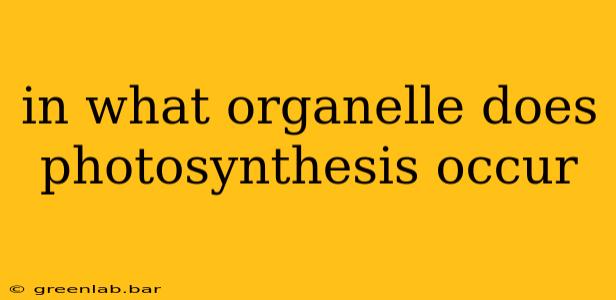Photosynthesis, the remarkable process by which plants and some other organisms convert light energy into chemical energy, takes place within a specialized organelle: the chloroplast. This isn't just a random location; the chloroplast's intricate structure is perfectly designed to facilitate this vital energy conversion. Understanding the chloroplast's role is key to understanding the very foundation of life on Earth.
The Chloroplast: Nature's Solar Power Plant
Chloroplasts are double-membrane-bound organelles found in the cells of plants and algae. They are often described as the "powerhouses" of plant cells, analogous to mitochondria in animal cells, but with a crucial difference: instead of generating energy from food, they generate it from sunlight. This energy is then stored in the form of sugars, fueling the plant's growth and development.
Key Structures Within the Chloroplast:
The efficiency of photosynthesis hinges on the chloroplast's internal structure. Several key components work together to capture and utilize light energy:
-
Thylakoid Membranes: These are flattened, sac-like structures stacked into grana (singular: granum). The thylakoid membranes are studded with chlorophyll and other pigments, which absorb light energy. This is where the light-dependent reactions of photosynthesis occur. The precise arrangement maximizes light absorption.
-
Grana: These stacks of thylakoids increase the surface area available for light absorption, significantly boosting the efficiency of photosynthesis. Think of them as solar panels arranged for optimal sun exposure.
-
Stroma: The stroma is the fluid-filled space surrounding the thylakoids. It contains enzymes and other molecules necessary for the light-independent reactions (also known as the Calvin cycle) of photosynthesis, where carbon dioxide is converted into glucose. This is where the chemical energy produced in the light-dependent reactions is used.
-
Chlorophyll: This is the primary pigment responsible for absorbing light energy. Different types of chlorophyll absorb different wavelengths of light, maximizing the amount of energy captured. Accessory pigments, such as carotenoids, also play a role in light absorption and protection against excessive light.
The Two Stages of Photosynthesis: A Chloroplast-Centric Perspective
The entire process of photosynthesis is neatly compartmentalized within the chloroplast, divided into two main stages:
1. Light-Dependent Reactions:
These reactions occur within the thylakoid membranes. Light energy is absorbed by chlorophyll and other pigments, exciting electrons and initiating a chain of electron transport. This process generates ATP (adenosine triphosphate) and NADPH, which are energy-carrying molecules crucial for the next stage. Oxygen is also released as a byproduct.
2. Light-Independent Reactions (Calvin Cycle):
These reactions take place in the stroma. ATP and NADPH produced during the light-dependent reactions provide the energy needed to convert carbon dioxide into glucose. This glucose is then used by the plant for energy, growth, and storage.
Beyond the Basics: The Evolutionary Significance of Chloroplasts
The presence of chloroplasts in plant and algal cells is a testament to the power of endosymbiosis – a theory proposing that chloroplasts originated from ancient cyanobacteria that were engulfed by eukaryotic cells. This symbiotic relationship revolutionized life on Earth, leading to the evolution of photosynthetic organisms and the oxygen-rich atmosphere we breathe today. The chloroplast’s unique structure reflects this fascinating evolutionary journey.
In conclusion, the chloroplast is not merely an organelle; it’s the engine room of photosynthesis, a highly specialized structure crucial for the production of energy that sustains the vast majority of life on Earth. Its intricate internal organization optimizes the process, highlighting the elegance and efficiency of nature's designs.

